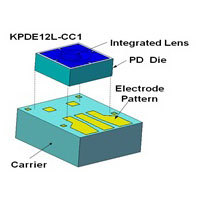News: Optoelectronics
29 June 2020
Kyoto’s new KP-H photodiode achieves 40GHz bandwidth
Japan’s Kyoto Semiconductor Co Ltd has developed the KP-H KPDEH12L-CC1C lens-integrated chip-on-carrier indium gallium arsenide (InGaAs) high-speed photodiode to support 400Gbps transmission systems that use PAM4 (Pulse Amplitude Modulation 4) both within and between data centers.
Currently, Kyoto has achieved transmission speeds of mainly 100Gbps by bundling 4 lanes of 25Gbps. However, there are growing demands in the market for 400-800Gbps transmission speeds. The Institute of Electrical and Electronics Engineers (IEEE) set the PAM4 standard, which corresponds with 4-bit signal to one modulation. The transmission speed per photodiode reaches 50Gps (= 400Gps/4 lanes/2 (PAM4)). The transmission bandwidth required for the photodiode to achieve this speed is 35-40GHz.
With the introduction of the new photodiode, Kyoto is supporting the increasing speeds and capacity requirements for transmission systems in 5G networks and beyond.

Picture: Mounting of the KPDEH12L-CC1C photodiode (with integrated condenser lens) on the carrier.
The 0.6mm x 0.48mm x 0.25mm size of the carrier on which the photodiode is mounted, and the width and length of the electrode pattern formed on the surface of the board (with little attenuation at high frequencies), are optimized using electromagnetic simulation. As a result, Kyoto claims that it has achieved an industry-leading 400Gbps and 40GHz as a frequency band with an integrated transimpedance amplifier. The KP-H photodiode has passed Telcordia GR-468-Core qualification (the standard reliability test for communication equipment).
As well as being mounted on a carrier that is optimally designed to achieve high frequency, a condenser lens is integrated on the backside of the KPDEH12L-CC1C photodiode, allowing incoming light to collect in the light absorption area, and making it easy to align the optical fiber with the photodiode. The photodiode chip is mounted on a carrier twice as big as the chip itself.
Mass production of the KP-H KPDEH12L-CC1C photodiode is scheduled to start in November.









